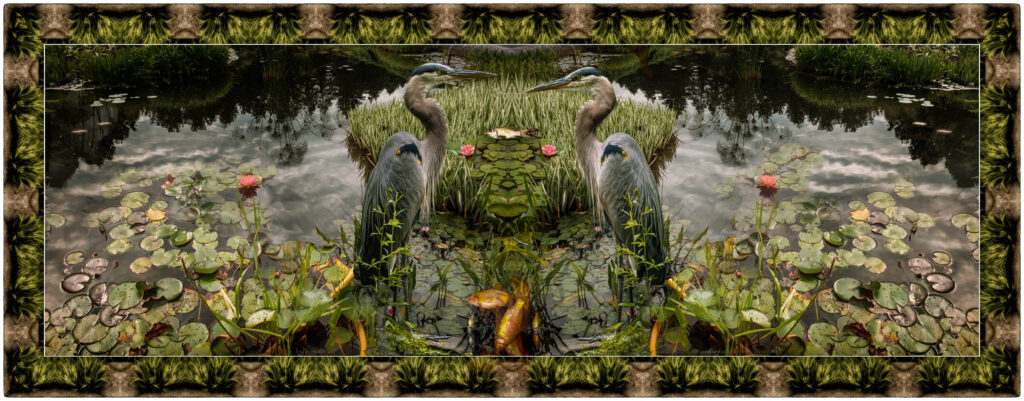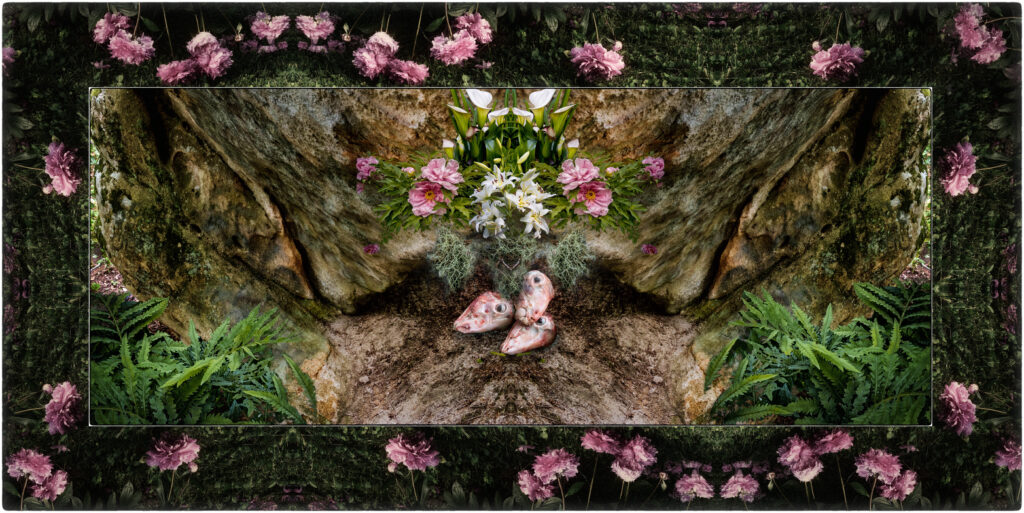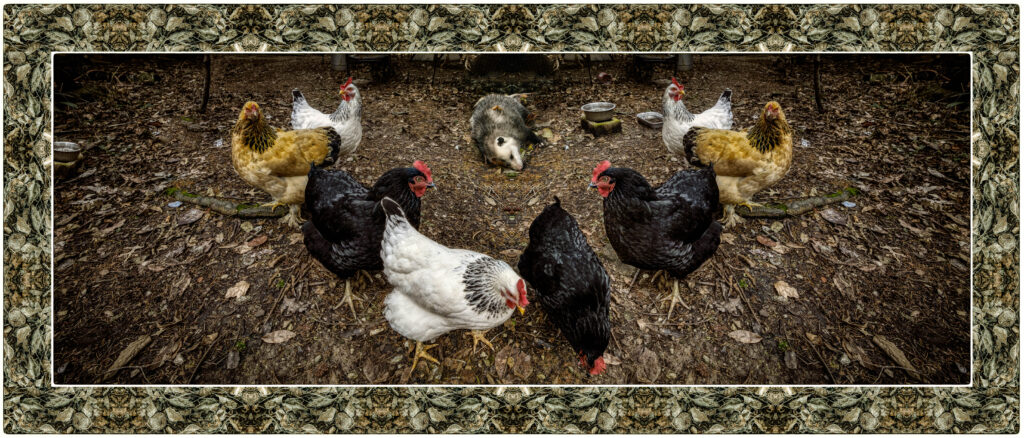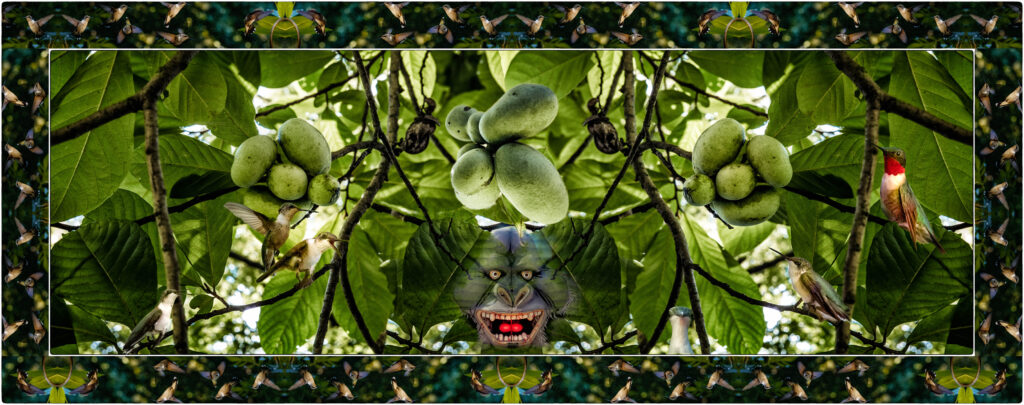It’s tempting to walk into Symmetry Breaking, a small but richly ambiguous exhibit of photo collages by the gifted Lexington photographer Melissa Watt at Institute 193, expecting it to be more about style than substance. Watt’s virtuosity with computer software and her apparently compulsive attention to detail in these heavily layered images might have called so much attention to themselves that we could have been forgiven for missing the forest for the digital trees.
It doesn’t, hasn’t, turned out that way. Although we’re aware that the show (in which Watt is continually sampling, inverting, repositioning, overlaying and otherwise obsessively manipulating her photography) is the product of an elaborate, no doubt intensely cerebral process, said process is not what the show is about. It has many things on its mind other than its own making.
What those things might be, viewers must determine on their own, not least because the artist herself offers nothing remotely like an explication. (Consistent with Institute 193’s practice, there are no wall labels – a mistake, I think, as Watt’s witty titles do sometimes contain small, valuable clues; nor does she offer an artist’s statement.) This is less problematic than it might seem, however, since there are so many possibilities to choose from.
One obvious place to start is telegraphed in the show’s title. The mirroring of duplicated and/or flipped elements in the pieces is saved from the status of a gimmick by the fact that Watt is always setting us up to expect the images to be perfectly symmetrical and then impishly, perhaps gleefully thwarting that expectation. The effect of having that optical rug pulled out from beneath us so regularly is to make us look harder at every element, searching for things that don’t face its twin across the median of the frame.
But this cat-and-mouse game that the artist is playing with us may be a bit of a feint. Watt is less interested in smoke and mirrors, it seems to me, than in setting up odd scenarios that feel like premises (or in some cases aftermaths) of eerie, dark, perhaps darkly comic fantasies that carry some of the dreamlike potency of fables and magic-realist folklore. She’s a storyteller, finally, or at least a suggester of stories – a fabulist who gets the tale started, then sends you off to finish it on your own.

In a collage called “After You” (2019), for example, two great blue herons – the same heron, fairly obviously, only cloned and flipped by Watt’s digital wizardry (though not entirely; notice, as the artist wants you to, the slightly different angle of the two heads, the two hungry, spearing beaks) – seem locked in a staring contest. The prize laid out between them, as if on a buffet table, is a small fish, not dull gold like the common koi underfoot but a delicate silver morsel, perfect for swallowing whole. After you, my ass. This is winner-take-all.
Or not. The above flight of fancy is just one possible interpretation of the piece. It might evoke, like Leonardo’s The Vitruvian Man, ancient notions of balance and, yes, symmetry. It might be an Orwellian allegory of nature’s cruel, sacred circle of life. It might be some form of self-dramatization by the artist, in something like the vein of Cindy Sherman, Anthony Goicolea, or that other Central Kentucky photo-collage artist named Melissa (Melissa Hall), except with animal avatars instead of human ones. It might be an oblique passion play – the crucified Christ (symbolized for centuries as a fish) lying on a slab, attended by winged angels – or an even more oblique reenactment of the Christian sacrament. Eat, this is my body.

If these interpretations sound far-fetched, they’re unmistakably reinforced – chillingly or amusingly (or perhaps both at once), depending on your perspective – in two other pieces in the show. “Spring Lamb” (2016) features another altar of sorts, upon which three lamb heads appear to have been flayed and arranged like delicacies on a plate in a fine-dining restaurant. Religious rites and symbols, including the burnt offerings of Abraham and the Lamb of God, come inexorably to mind.

Then there’s my favorite piece in this group, “Meanwhile, the World Goes On” (2019), in which a dead opossum is ritualistically, perhaps ominously surrounded by a semicircle of chickens. The hens are doubled (plus one) in Watt’s usual symmetrical/asymmetrical manner, but that’s the least interesting thing about the picture. The mind – at least my mind – reels at the narrative and dramatic possibilities of the scene. Was the opossum shot as an intruder, and if so by whom? Was it murdered with malice aforethought? Was it sacrificed as an offering to the dark poultry gods? Is this a vigil of some sort, at the end of which the opossum will ascend to the heavens, leaving his flock astonished, awaiting a second coming?
You think these responses are over the top? I refer you back to the pictures.
In the end, of course, the artist’s intent is less important than what we make of what’s in front of us here, which is plenty. Certainly the works in Symmetry Breaking are not merely decorative pieces, despite the many ways they ravish the eye. They’re most assuredly not empty exercises in digitally manipulated photography. Their visual density and resonant webs of symbols invite not just interpretation – in something like the way objects in commissioned portraits from the Renaissance tell us about their human subjects – but multiple, sometimes simultaneous interpretations. That’s one of the overall show’s chief strengths, though not its only one.

Another pleasure the artist offers us here, for example, is the opportunity to register her echoes of various threads and periods of art history, from 17th-century Dutch and Flemish still-life paintings of dead game animals and fish waiting for the stew pot to the koi ponds and water lilies of ancient China and feudal Japan. The emphasis on the sky’s reflection on a pond’s surface in “After You” seems to locate us in a funhouse version of Monet’s home in Giverny. The grinning beast with bloody teeth in “Monkey in the Pawpaws” (2019) seems like a descendant of Henri Rousseau’s jungle critters. And the intricately cloned and mirrored borders that frame each piece in the show bring with them musty whiffs of fairytale book illustrations, which have a way of fostering the romantic and/or gothic atmospheres of the pictures, and of medieval illuminated manuscripts, which may nudge some viewers in ecclesiastical directions.
Watt has expanded and extended those ornate borders in vertical elements affixed to the wall behind most of the pictures at Institute 193. In a much larger exhibit space, this might have been a coup de théâtre, an amplification of the decorative aspect of these images in multiple dimensions. As it is, these secondary elements threaten to overwhelm the main events they’re meant to enhance, not to mention the small gallery itself. They overstate, unnecessarily so, what is already abundantly clear: that Symmetry Breaking is one of the best art shows Lexington has seen in quite a long time.
“Melissa Watt: Symmetry Breaking” continues through September 30 at Institute 193, 193 North Limestone Street in Lexington.




